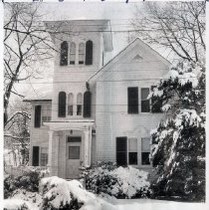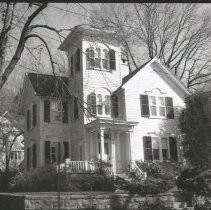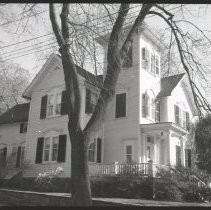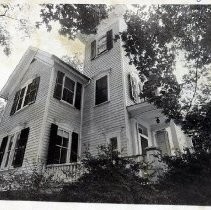Two Grove Street
Introduction
Text-to-speech Audio
Number Two Grove Street, a private residence, is an Italianate-style building located in the North Grove Street Historic District in Tarrytown, NY. Built in 1860 for Marcus Raymond, former editor of the Tarrytown Argus newspaper, the house is constructed of wood, unlike the other brick houses located in the district. Bequeathed to Raymond’s daughter, Lizzie See, in 1901, the home has had several private owners since. The house is L-shaped, with a tower nestled into the angle of the two wings, and a front entrance sheltered by a simple porch. The North Grove Street Historic District, which includes Two Grove Street, was added to the National Register of Historic Places in 1979.
Images
Ogden house, 2 Grove Street

Ogden residence, 2 Grove Street

Ogden residence, 2 Grove Street


Backstory and Context
Text-to-speech Audio
The North Grove Street Historic District in Tarrytown is where a small number of prosperous members of Tarrytown’s merchant and professional class built homes for themselves and their families during the mid-1800s. Number Two Grove Street was constructed in 1860, a neighbor to the first house built on the street in 1848.
Number Two Grove Street was designed for Marcus D. Raymond, the owner and editor of the Tarrytown Argus newspaper, which had started out as The Tarrytown Advertiser and was once the only paper in the village. Under Raymond’s ownership and administration, the Argus ran a weekly news cycle. It was sold in 1909, eight years after Raymond’s death, to the Mount Pleasant News, which converted it to a daily paper three years later.
Raymond’s house on North Grove Street was built in the Italianate style, a popular architectural choice for those who could afford it during the period just before the Civil War. The home is in an L-shape and possesses a tower wedged within the two wings of the house. The facades are covered by clapboarding with double and single one-over-one sash windows appearing on all faces. The windows are bedecked with decorative entablatures and some include round arches. The door to the home is protected from the elements with a roofed porch entrance. A two-story rear addition was added to the home for a new kitchen.
After Marcus Raymond died in 1901, the original home passed to his daughter Lizzie See. After See, the home was owned by the Steurer family, originally from Greenville, South Carolina. Since the Steurer family moved out, the home has changed hands several times. It remains a private residence.
Sources
- Canning, Jeff and Wally Buxton. History of the Tarrytowns, Westchester County, New York, from Ancient Times to the Present. NY, NY: Harbor Hill Books, 1993.
- French, Alvah P., and Will Leach Clark. “Section 13.” Essay in History of Westchester County, New York 3, 3:127–31. Westchester County, NY: Lewis Historical Publishing Company, 1925. https://books.google.com/books?id=eptQAQAAMAAJ
- “North Grove Street Historic District #79001650.” National Register of Historic Places. United States Department of the Interior/National Park Service. 1979. https://catalog.archives.gov/id/75323135
- The Historical Society, Inc., Serving Sleepy Hollow and Tarrytown website. https://www.thehistoricalsociety.net
- Williams, Gray. Picturing Our Past: National Register Sites in Westchester County. Elmsford, NY: Westchester County Historical Society, 2003.
Westchester County Historical Society
Westchester County Historical Society
Westchester County Historical Society
